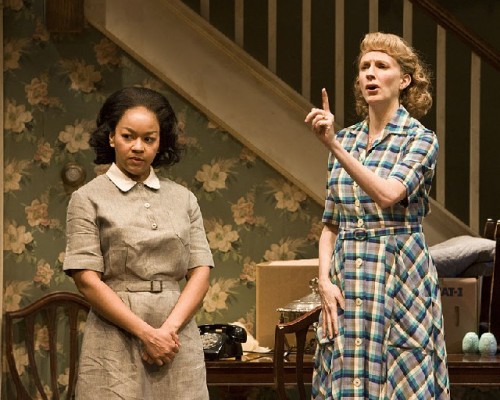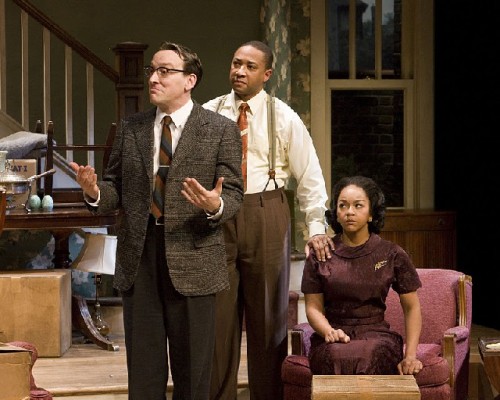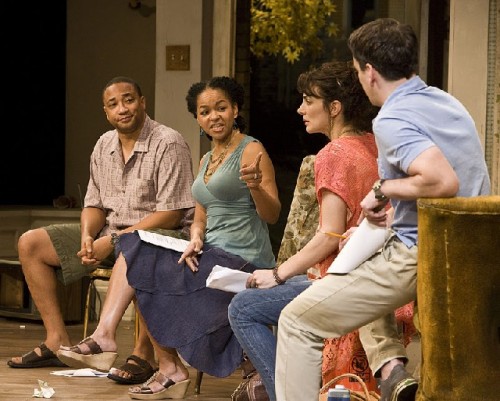Clybourne Park by Bruce Norris
There Goes the Neighborhood
By: Charles Giuliano - Apr 18, 2012
Clybourne Park
By Bruce Norris
Directed by Pam McKinnon
Scenic Design, Daniel Ostling; Costume Design, Ilona Somogyi; Lighting Design, Allen Lee Hughes; Sound Design, John Gromada; Hair and Wig Design, Chalres LaPointe; Casting, Alaine Alldaffer; Production Management, Aurora Productions; Production Stage Manager, C.A. Clark; Press, O&M Co.
Cast: Crystal A. Dickinson (Francine/Lena), Brendan Griffin (Jim/Tom/Kenneth), Damon Gupton (Albert/ Kevin), Christina Kirk (Bev/ Kathy), Annie Parisse (Betsy/ Lindsey), Jeremy Shamos (Karl/ Steve), Frank Wood (Russ/Dan)
Walter Kerr Theatre
218 West 48th Street
New York City
It is 1959 in Clybourne Park a white, middle class suburb of Chicago. Bev (Christina Kirk) and Russ (Frank Wood) are packing to leave the house they have just sold. To whom becomes the plot point that drives the highly regarded play by Bruce Norris that has followed a long and winding road to Broadway.
Initially, it opened Off Broadway at Playwrights Horizons, February 21, 2010 and closed on March 21, 2010. The production evoked critical acclaim but had problems finding backers. Since then it has been staged both in London and several regional American theatres. It is penciled in for its New England premiere next season at Boston’s edgy Speakeasy Theatre. The play arrives on Broadway with the 2011 Laurence Olivier Award for Best New Play and the 2011 Pulitzer Prize for Drama. Based on this formidable recognition, and compelling back story, critics suggest that it will be nominated for this season’s Tony awards.
While Russ is seemingly buried in an arm chair, lost in thought, or scanning through magazines, Bev is a blur of ditsy activity. Flying about with flailing, spastic arm movements in a hideous housedress of the period (aptly designed by Ilona Somogyi) she reminded me of Edith Bunker (Jean Stapelton) the wife of Archie Bunker in the classic TV show All in the Family. There is the similar chemistry of her disconnected but sincere focus on keeping things together and his cynical, sedentary sarcasm.
Bev is focused on the task of packing up and keeping a lid on the emotions that entails. She is trying too hard to do and say the right thing while everything goes haywire. Compared to her frenetic, clueless whirlwind is the methodically calm and grounded demeanor of her black domestic servant, Francine.
Although they are not connected the relationship between the desperate housewife, Bev, and the reserved, wise and accommodating Francine plays like a scene from the film The Help. With the notable difference that there is none of the subversive push back from Francine that made the film so remarkable and insightful.
It is a one sided relationship between employer and servant which Bev falsely construes as friendship. As a signifier of that gap Bev tries to give Francine an unwanted gift, a chafing dish. Although she says that she never found a use for it the object is a present for years of loyal service. On Francine’s part there is more to chafing than just the damned dish. As Francine does a slow burn Bev is oblivious to the callousness of her gesture.
There is a bit of back and forth about who will take the trunk down from upstairs. It seems that their son Kenneth, a veteran of the Korean War, hung himself in his bedroom. The house is haunted and the couple is eager to leave behind its unhappy memories.
While busy packing they are visited by the vicar (Brendan Griffin) and then neighbors Karl (Jeremy Shamos) and his pregnant, deaf wife Betsy (Annie Parisse). It has been learned that the house is being sold to a black family. On behalf of the neighborhood Karl first argues then pleads to abort the sale. The dialogue is initially civil but ratchets up into angry defiance.
When Albert (Damon Gupton) arrives to pick up his wife Francine he too is offered the chafing dish. Bev just doesn’t know when to quit. Or is it the playwright Norris? While Bev evokes laughs from the audience the lines, throughout the play, particularly in the free for all of the second act, often made me cringe and wince.
Albert is dispatched upstairs (although he is not an employee) to help Francine bring down that trunk. It comes crashing down with a thud that provokes the explosive end of the first act.
Faced with the pleading of Karl and the Vicar to do the right thing, and not sell to the black family, Russ loses it. The trunk is filled with the letters and memorabilia of their tormented dead son. Today, of course, we would readily recognize that Kenneth suffered from Post Traumatic Stress Disorder. He was a survivor of the horrors of America’s Forgotten War. Karl, the Vicar, and their righteous white, middle class neighbors, didn’t lift a finger to help a troubled, grieving family. To Russ’s way of thinking his action has an element of poetic justice.
It becomes apparent that the black family moving in are the Youngers, the protagonists of Lorraine Vivian Hansberry’s (May 19, 1930 – January 12, 1965) A Raisin in the Sun. The neighbor, Karl, is Karl Lindner, the minor character from that play who attempts to talk the Youngers into abandoning their plans to move into the neighborhood.
During act two we are in the same living room in 2009 but fifty years have brought changes to Clybourne Park. The concerns of Karl and the Victor have run full cycle. When the Youngers moved in there was indeed a white flight to the suburbs. Taking advantage of depressed property values it was transformed into a black neighborhood. With a twist that motivates the second half of the drama.
The transformation of houses, neighborhoods and communities evokes the incremental changes of decades in the Century Cycle of ten plays by August Wilson. His plays chronicled those changes with the gravitas and irony of a black perspective. Norris navigates similar terrain with broad, outrageous humor and mordant satire.
What had been home to the Youngers family has become a derelict, abandoned property. In the scenic design of Daniel Ostling the walls are scrawled with graffiti, both hip hop and tagged, as well as desecrated and abandoned. There is the implied aura of a haunted house with the ghost of Kenneth who took his life.
This history is apparently unknown to the yuppie, white blockbusters who plan to raze the house and replace it with a somewhat scaled down McMansion. They are discussing these plans with a group going over guidelines and restrictions pushed through under the guise of historic preservation by Clybourne Park’s African American residents. Although now run down there is a legacy and nostalgia for the black families raised in this community.
The group assembled to discuss these changes are comprised of the reconfigured players from the first act. They have threads that connect them to the first set of characters. Representing the black community are Lena (Dickinson) and her husband Kevin (Gupton). It seems that Lena is related to Francine the domestic. The lawyer, Kathy (Kirk), is descended from the deaf wife of Karl. Her family left shortly after Bev and Russ sold their home. Of the buyers Steve (Shamos) has in common with Kevin a mutual black friend. The only one in Steve’s high school. Although small it seems that the scrappy youngster kicked Steve’s butt. This surprises and amuses Kevin. His pregnant wife Lindsey (Parisse) played the pregnant deaf woman.
Efforts to get through the paper work in a timely manner are constantly disrupted by cell phone calls. The meeting is chaired by Tom (Griffin) representing the neighborhood association.
Initially, the meeting is civil and business like. Lena is committed to having the new comers understand and respect the heritage of the community. However now run down and crime ridden. She wants to make a statement to the group to clarify her intentions and spirit. But this is constantly disrupted.
Awkwardly, there are misguided attempts to combine business with pleasure. Steve, who is a bit of a jerk with an ability to say the wrong thing at the wrong time, wants to tell a joke told to him by his black friend. It’s something about a white man newly arrived in a prison cell with a black man as a roommate.
Dim witted as he is, encouraged by Kevin, he blurts it out. The joke is offensive, and worse, not particularly funny. Steve’s lame defense is that it was told to him by a black “friend.” This unleashes an avalanche of ever more raunchy and outrageous jokes.
Finally Lena manages to insert her poignant statement. It causes a thoughtful pause in the group. Steve thinks he has a handle on the situation. Falteringly he states that what is happening here is that “We are tap dancing around the topic of race.”
Kevin brings the house down when, looking at Steve with mock wonder, he says “Do you know how to tap dance?” The absurdity of the notion is hilarious. As is Lindsey’s predictable comment, another howler for the audience, that “Half of my friends are black.” She is quickly reminded that some of those “friends” are her fellow employees. They don’t count as friendships any more than Bev’s notion that the maid Francine was her “friend.”
Until now Lena has been notable for her tact and reserve. But the gloves come off as she delivers the show stopping zinger of all zingers. Something about comparing a white woman and a tampon.
The play ended, wound down, but was not really resolved. Or ever could be. I’m not sure of what I gained from the experience other than self conscious, awkward amusement. The comedy based on race was on many levels too close for comfort. The humor worked by triggering and playing on deeply rooted clichés.
While the playwright is lauded and applauded the writing too often crosses the lines of taste and decency. In features about the play the actors have described the collateral damage of inhabiting their characters and delivering such charged and insensitive lines. Their concerns spilled over to me as a member of the audience. Norris playing race for laughs in an evolving urban context, to me, compares unfavorably to the daunting treatment of that similar subject matter by Wilson.
Arguably, having experienced the sobering and thoughtful work of Wilson it is now logical to evolve to the comic release of Norris. Seen in the proper context it may be regarded as progress. It just seems to lack the dignity and respect that Lena was striving for. But it also seems miscalculated and unjust that all of the moral high ground is given to Francine/ Lena while the white characters are a ship of fools.






